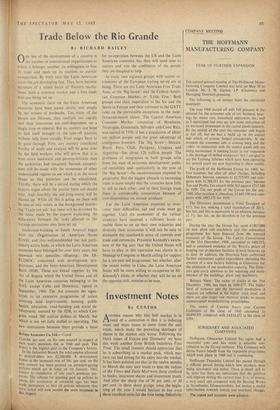Trade Below the Rio Grande
0 NE test of the development of a country is the number of international organisations to which it belongs; another, its willingness to free its trade and open up its markets to outside competition. By both tests the Latin American countries are developing fast. They have become . members of a whole batch of Western institu- tions; both a common market and a free trade area are being set up
The economic facts on the Latin American countries have been stated clearly and simply by the writers of textbooks. Too many of the People are illiterate, they multiply too rapidly and their economies are over-dependent on a single crop or mineral. But no country can hope to find itself brought to the take-off position without help from outside. Four stages have to be gone through. First, any country considered worthy of study and analysis will be gone over by the field workers who will prove that it is even more backward and poverty-stricken than the authorities had imagined. Second, compari- sons will be made with the economies of other undeveloped regions to see which is in the worst shape so that priorities can be established. Thirdly, there will be a period during which the experts argue about the precise form aid should take. AO. fourthly, the aid programme will be started up. While all this- is going on there will be one or two voices in the background mutter- ing 'Trade not aid,' but these will be drowned by • the noise made by the experts explaining the differences between the tasks allotted to the various institutions they have set up.
Institution-building in South America- began with the Organisation of American States (OAS); and this well-established but not parti- cularly active body, to which the Latin American countries have belonged for over sixty years, has spawned two specialist offspring: the IA- ECOSOC. concerned with development pro- grammes; and the Inter-American Development Bank (IDB). These are linked together by the Act of Bogota which the United States and all the Latin American countries belonging to the OAS, except Cuba and Dominica, signed in September. 1960. The Act commits the signa- tories to an extensive programme of action covering land improvement, housing, public health, education, road-building and social de- velopment; assisted by the IDB, to which Con- gress voted 500 million dollars in March, but Which is not yet fully staffed or operating. The new institutions between them provide a basis
for co-operation between the US and the Latin American countries, but they will need time to mature and win the confidence of the people they are designed to help.
In trade, two regional groups with names re- miniscent of the European trading set-up are in being. These are the Latin American Free Trade Area, or the 'Big Seven'; and the Central Ameri- can Common Market, or 'Little Five.' Both groups owe their inspiration to the Six and the Seven in Europe and their existence to the GATT rules on the permissible exceptions to the most- favoured-nation clause. The Central American Common Market. consisting of Honduras, Nicaragua, Guatemala, Salvador and Costa Rica. was started in 1958; it has a population of about ten million people and the great advantage of contiguous frontiers. The 'Big Seven'--Mexico, Brazil. Peru, Chile, Paraguay, Uruguay and Argentina--has about 120 million people. The problems of integration in both groups arise from the state of economic development, politi- cal instability, and—particularly in the case of the 'Big Seven'--the inconveniences imposed by geography. But the biggest obstacle to increasing trade is quite simply that the countries have little to sell to each other; and in their foreign trade there is considerable competition because of over-dependence on certain products.
For the Latin American countries to over- come their difficulties, aid and trade must go together. Until the economies of the various countries have received a sufficient boost to enable them to set up their own industries and diversify their economies it will not be easy to dismantle the ramshackle array of controls over trade and currencies. President Kennedy's aware- ness of the big part that the United States will have to play in this operation was shown in a Message to Congress in March calling for support for a ten-year aid programme; but whether, after the recent events in Cuba, the Latin American States will be more willing to co-operate in Mr. Kennedy's plans, or whether they will be set on the opposite tack, remains to be seen.






































 Previous page
Previous page